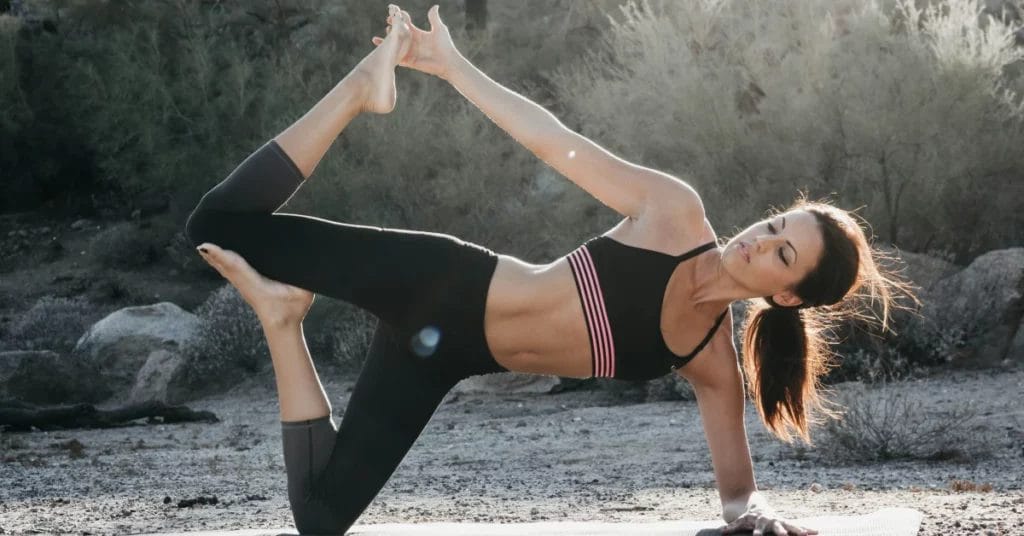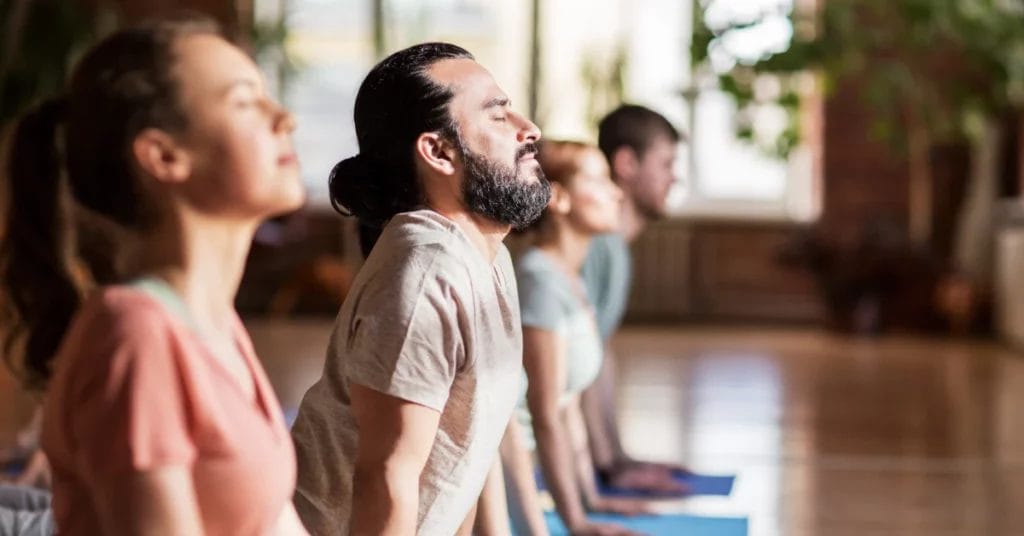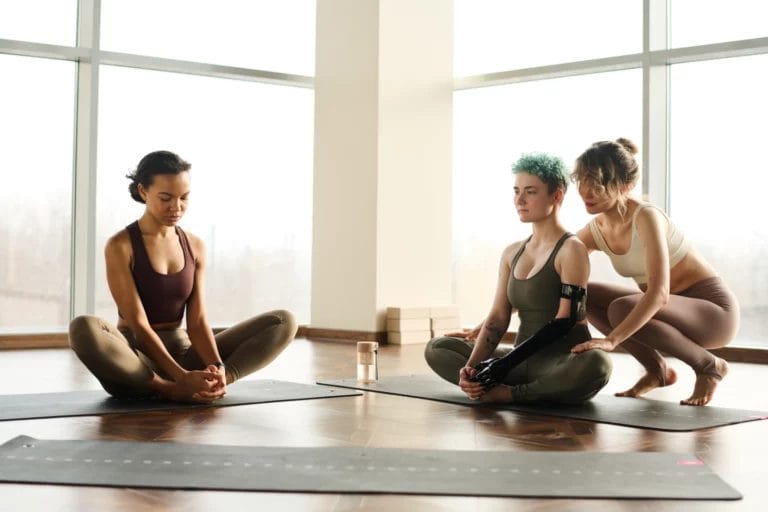
Last Updated: Aug 26, 2025
Asanas and pranayama you know. General or professional liability insurance, maybe not.
Breaking Down the Basics of Liability Insurance for Yoga Teachers
Insurance can be confusing on the best of days. What is liability insurance? How does it apply to yoga instructors? And what do all these insurance terms mean?
Let’s start from the beginning and review everything you need to know, bit by bit, step by step.
What Is Yoga Teaching Insurance?
Yoga instructor insurance is designed to protect you from financial losses associated with your work as a yoga teacher. In other words, it helps you pay for things like injuries and property damage that occur as a result of your work.
Insurance Canopy policies offer what’s known as liability insurance, or liability coverage. This means it applies to incidents affecting people and property other than you and your things.
Liability insurance covers third parties.
First party = You.
Third parties = Not you.
(Second party = Us, your insurance company.)
Yoga liability insurance helps pay for things like medical bills, claims, or lawsuits that may be brought against you. It also offers peace of mind and meets most gym, studio, and other insurance requirements.
Common Yoga Liability Insurance Requirements
Most studios, gyms, and other spaces will require you to have general and professional liability insurance to work there. They may ask to see your Certificate of Insurance (COI) or ask that you add the facility as an additional insured on your policy.
General Liability Insurance
General liability insurance applies to bodily injury and property damage claims arising out of your work.
Bodily injury applies to things like a client spraining a knee or falling and cutting open their chin. Property damage applies to things like cracking a mirror or dropping a kettlebell on a client’s phone.
Professional Liability Insurance
Professional liability insurance is designed for claims related to physical or financial harm your professional services or advice cause to a client.
Professional liability insurance is also called Errors & Omissions Insurance and/or E&O Insurance.
Additional Insureds
Additional Insureds
An additional insured (AI) is another person, business, or entity that could be held responsible for accidents you caused.
For example, a student gets hurt during your hot yoga class, so they sue both you and the studio where the class took place. If the studio is named on your policy as an Additional Insured, the protection afforded to you also extends to them.
Additional insureds can be: an employer, landlord, studio manager, gym owner, event manager, city, and others.
Additional insureds cannot be: friends, family members, your employee, coworkers, and other teachers.

How Much Does Yoga Liability Insurance Cost?
The cost of yoga liability insurance from Insurance Canopy starts at $159 per year. We also offer monthly payments for as low as $15 per month.
Optional coverages like cyber liability and additional insureds come with slight additional costs. What doesn’t raise the price of our policies: teaching in multiple locations, teaching virtually, in person, or both; the number of hours you teach, or where you live.*
You deserve quality coverage at all stages of your career, which is why we cover student teachers under the same plan. So as you progress through your yoga teacher training, your policy can go with you at no extra charge!
*Currently not for sale in Missouri.
Types of Yoga Insurance Coverage to Consider
While general and professional liability make up the base of most yoga insurance policies, additional coverage types help cover you for the various kinds of risks associated with wellness professions.
These coverages are included in Canopy yoga instructor policies:
- General Liability: For physical injuries or accidents that harm others and take place in the space where you teach.
- Products Completed Operations: For physical injury or property damage caused by a product during or after your class, like a faulty strap that snaps and hurts a student.
- Personal and Advertising Injury: For harm or damage that is not physical/bodily harm. Typically applies to things like invasion of privacy, libel, slander, and copyright infringement. Included under General Liability.
- Professional Liability: For injuries or damages to others caused by your professional services, advice, or instructions.
- Damage to Rented Premises: For damages to a space you rent for teaching yoga.
- Medical Expense Limit: For the medical bills of someone who was injured in or around your class, regardless of fault.
These coverages are available as optional add-ons:
- Gear & Equipment Coverage: For help replacing items you use to teach classes and run your business in the case of damage or theft. This applies to things like mats, blocks, and filming equipment used for online and virtual classes.
- Cyber Liability: For help with the cost of lawsuits, damages, and restitution that result from a cyber attack on your business where personal and private information is stolen.
- Diet & Nutrition Coverage: For nutrition services you may offer, like general diet education or meal plan examples.
- Sexual Abuse & Molestation (SAM) Insurance: Coverage for defense costs if you’re wrongly accused of sexual harassment or improper conduct, like a client accusing you of touching them inappropriately while correcting their form.
-
Gear & Equipment insurance is also called Inland Marine insurance.
Comprehensive coverage allows you to teach with greater peace of mind knowing you’re protected from various potential risks.

What Does Yoga Insurance Cover?
A yoga liability policy protects you against the cost of claims related to incidents like these:
- A student trips and falls in a class because it was too crowded, and they want to sue
- You accidentally dislocate a student’s shoulder while helping them perform a pose, and they need medical attention
- A student accuses you of causing their carpal tunnel due to the prolonged holds you include in class
- A resistance band slips out of a student’s grasp and shatters a mirror on the wall, and the studio wants you to pay for the replacement
What Does Yoga Insurance Not Cover?
Some examples of what yoga liability policies may not cover:
- You get hurt while teaching a class and need physical therapy. This would require a first-party policy like your own health insurance or coverage through a workers’ compensation program.
- You sub for another instructor’s stand-up paddle (SUP) board yoga class. Someone falls off their board, loses the paddle, and cuts their foot. Many policies don’t cover SUP yoga classes.
- A pipe bursts in a studio space you’re renting, which causes flooding. Liability insurance doesn’t cover this type of claim, but commercial property insurance might.
Common Risks Involved with Teaching Yoga
Teaching yoga, like any physical activity, involves certain risks. Some of the most common include:
- Physical injuries to students: Yoga involves physical movement, so there’s always a chance a student might strain a muscle, slip, fall, or experience other injuries.
- Overexertion or incorrect form: Students might overexert themselves or practice poses incorrectly outside of class. You could be held liable if a student believes your guidance led to their injuries.
- Injuries from adjustments: When you assist students in achieving the correct posture or a deeper stretch, there’s a risk of injury, especially if the student has physical limitations.
- Health risks: Yoga might not be suitable for everyone, especially those with certain health conditions. If your class worsens their condition or triggers a medical event, you could be held responsible even if you didn’t know about the condition.
- Property damages: If a class is conducted in a rented space or studio, any accidental damage to the property during the session could become your financial responsibility.
- Legal and financial risks: This includes things like breach of contract (not fulfilling agreements or promises you made), defamation (libel, slander), or other legal issues that can occur while running a yoga business.
These risks are why every yoga instructor needs liability insurance. They’re also why you should require a health history form and a yoga liability waiver from every student.
-
Health History Forms
Gives you the information you need to assess a students’ realistic physical abilities, their medical conditions, or if they need a doctor’s okay before starting yoga.
-
Yoga liability waivers
Informs students about the potential risks involved in yoga. When they sign, they indicate that they understand the risks, and still agree to participate. (This idea is also referred to as informed consent.)

What Risks Do Yoga Instructors Face When Teaching Online?
You face the same risks as an in-person studio instructor when teaching yoga virtually or through prerecorded videos online.
It doesn’t matter if you teach virtually or in person — once you accept money for your instruction, you’re running a business and you’re exposed to the risks that come with it.
Do I need insurance if I teach yoga at home or online?
What kind of insurance would I need? The same coverages you get to teach yoga in person!
Insurance Canopy yoga policies cover you for virtual and in-person instruction.

Navigating Yoga Insurance Claims
It doesn’t take a drastic mishap on your part to cause an injury that triggers a claim or lawsuit. Some real claims that made headlines involved a rogue iguana and an out-of-control car.
While we hope you never have to file a claim, we’re here to help when you do. If there is an injury in class, or you experience another event that could turn into a claim, here are some tips to help you handle it.
- If there is a serious injury, call 911 or an appropriate medical care provider — if necessary, provide first aid or CPR
- If there was a crime, file a police report
- Document the incident with as much detail as possible
- Date and time of incident or loss
- Location of the incident, and any other relevant environmental details
- If appropriate, take photos of the location, damages, and/or bodily injuries as a result of the incident
- Names and contact information of everyone involved, as well as witnesses and first responders
- Notify your insurance company as soon as possible and/or file a claim
How to File a Yoga Insurance Claim and What to Expect
If you need to file a claim you can do so online from your online customer dashboard at any time. Here’s what you need to do:
- Gather all necessary information and paperwork
- If possible, have a police report ready outlining a theft or incident
- Log in to your online account
- Locate the “Manage Policies” section and click on “File A Claim”
- Fill out the necessary info and submit your claim.
Our team will reach out within 24-48 hours to confirm we have received your claim and are working on it.
You will then be contacted by your claims adjuster with a claim number. You’ll be able to ask them questions, and they may ask you for additional information like photos or receipts.
Depending on the claim, it can take a few weeks to a few months to resolve. Be sure to keep a copy of your claim and any related documents.

Benefits of Insurance Canopy’s Liability Insurance for Yoga Instructors
Insurance Canopy is committed to providing the high-quality yoga coverage you deserve with the following benefits:
- Meets or exceeds yoga insurance requirements
- Covers you for common claims
- Affordable, starting at $15/month
- Provides optional additional coverage, like protection for stolen gear
- Takes 10 minutes or less to buy online
- Gives you access to an instant Certificate of Insurance (COI)
- Offers annual and monthly payment options
- Covers you in multiple locations
- Covers over 40 styles of yoga
- Allows you to add unlimited additional insureds
- Automatic access to exclusive benefits
- Has a nearly 5-star customer service rating
Insurance Canopy’s Yoga Insurance Coverage Details
General & Professional Liability Limits
$3,000,000
$3,000,000
The amount your policy will pay for claims arising out of one or more of the following offenses:
– False Arrest, detention or imprisonment
– Malicious prosecution
– Wrongful Eviction or Wrongful Entry
– Oral or written publications that slander or libels a person or organization
– Oral or written publication or material that violates a person’s right of privacy
– The use of another’s advertising idea in your advertisement
Included
The maximum the insurance carrier will pay for a bodily injury or property damage claim that you become legally obligated to pay due to your business and professional services.
$2,000,000
Applies to damage by fire to premises rented to the insured and to damage regardless of cause to premises (including contents) occupied by the insured for 7 days or less.
$300,000
$5,000
The amount we deduct from a claim before paying up to your policy limits.
$0
Optional Add-ons
Price
$1.33–$10.67/month
The maximum amount paid out in the case of a cyber attack on your business. Because this coverage is not automatically included in the standard General Liability Policy, you will need to opt into this coverage. See the application for additional coverage details for Cyber Liability Insurance.
$8.25/month
$6.83/month
Coverage for a third party, such as a business, property owner, event organizer, or employer who could be named in a claim arising from your business operations. It cannot be used for employees, friends or family, other trainers, yourself, or other businesses you may own. Add one additional insured for $15, or choose unlimited additional insureds for $30..
$15–$30/year
-
Aggregate:
The total amount your policy will pay in one policy period.
-
Occurrence:
The amount your policy will pay for one single incident/claim during a policy period.
Get Peace of Mind With Dependable Yoga Liability Insurance
At Insurance Canopy, we pride ourselves on openness and clarity throughout the insurance buying process. Our goal is to be your trusted insurance partner as you grow your business.
Don’t leave yourself vulnerable to the risks associated with your yoga instruction. Safeguard your business by purchasing your policy from Insurance Canopy today.





